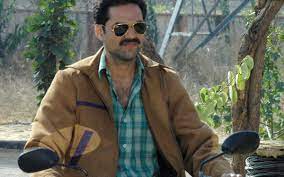— A Review by Maitreya Pawar
An underappreciated neo-noir film with a gripping story, despite pacing and ending concerns
“Ye sheher bhi mere jeevan ki tarah lagne laga tha—sukha, khushk, niras aur pyaasa… shaayad registan aise hi bante hain.”
 Amidst the cinematic tapestry of Bollywood, emerges a forgotten gem from the 2000s: Manorama Six Feet Under. Venturing into the unforgiving heart of Rajasthan’s Lakhot, this slow-burning crime thriller takes audiences on a journey into the parched landscapes of both a desert town and its protagonist’s soul.
Amidst the cinematic tapestry of Bollywood, emerges a forgotten gem from the 2000s: Manorama Six Feet Under. Venturing into the unforgiving heart of Rajasthan’s Lakhot, this slow-burning crime thriller takes audiences on a journey into the parched landscapes of both a desert town and its protagonist’s soul.
Manorama Six Feet Under, helmed by the enigmatic Abhay Deol, remains an unheralded masterpiece. In this narrative oasis, we find Deol playing the part of a junior PWD engineer secretly pursuing a literary dream. Struggling to sell more than 200 copies of his detective novel “Manorama,” he finds himself ensnared in the arid monotony of his life, juxtaposed against the stark beauty of the land he inhabits.
 The winds of change blow as a mysterious woman knocks on his door, thrusting him into a labyrinthine affair involving her politician husband. The very ground trembles with deceit as a controversial canal project looms over the village, embodying the tension between promises of prosperity and the scepticism of civil society organizations. Abhay Deol’s character, “SV,” believes he has uncovered the truth, only to realise that the enigmatic phrase “Manorama, age 32” is the gateway to unravelling a web of lies. In the heart of this narrative storm, SV grapples with his newfound role as the protagonist of his own story, navigating a plot as intricate and winding as the desert roads. While the film’s pacing might have been more concise, a soul-stirring background score resonates with the echoes of Rajasthan’s folk music, evoking the land’s mystique.
The winds of change blow as a mysterious woman knocks on his door, thrusting him into a labyrinthine affair involving her politician husband. The very ground trembles with deceit as a controversial canal project looms over the village, embodying the tension between promises of prosperity and the scepticism of civil society organizations. Abhay Deol’s character, “SV,” believes he has uncovered the truth, only to realise that the enigmatic phrase “Manorama, age 32” is the gateway to unravelling a web of lies. In the heart of this narrative storm, SV grapples with his newfound role as the protagonist of his own story, navigating a plot as intricate and winding as the desert roads. While the film’s pacing might have been more concise, a soul-stirring background score resonates with the echoes of Rajasthan’s folk music, evoking the land’s mystique.
As the tapestry of characters unfolds, Vinay Tripathi embodies Brij, the unwavering policeman, while Nawazuddin Siddiqui brings luminescence to a small-time goon. Yet, Raima Sen’s character arc feels like an abandoned oasis in this arid narrative landscape. Abhay Deol shines with his subtle embodiment of SV, the relentless truth-seeker. However, the story yearns to delve further into his motives, his battles against the mighty, and the fervour that propels him to stake his life and his loved ones’ in the quest for truth.
 Through the film’s lens, the age-old tale of David versus Goliath is mirrored in a tank teeming with fish, emblematic of the ruthless hierarchy of survival. This symbolism reverberates through the narrative, a relentless reminder of the predator-prey dynamic that governs not only the desert but also the power corridors. The film’s bait is enticing, though at times the hook might not sink deep enough to reel in every viewer. The crescendo of revelations might not be the thunderous climax some anticipate, yet it ripples with a resonance that lingers beyond the final frame.
Through the film’s lens, the age-old tale of David versus Goliath is mirrored in a tank teeming with fish, emblematic of the ruthless hierarchy of survival. This symbolism reverberates through the narrative, a relentless reminder of the predator-prey dynamic that governs not only the desert but also the power corridors. The film’s bait is enticing, though at times the hook might not sink deep enough to reel in every viewer. The crescendo of revelations might not be the thunderous climax some anticipate, yet it ripples with a resonance that lingers beyond the final frame.
In the end, Manorama Six Feet Under stands as a testament to the desert’s capacity to cloak its truths. The film’s intricate layers unfold with the night’s whisper, evoking a sense of mystery, suspense, and the allure of the unknown. As the credits roll, it becomes clear that while the desert may be barren, it conceals its secrets with finesse as skilled as the artistry behind this cinematic tale.
In summary, Manorama Six Feet Under invites us to explore the labyrinthine alleys of deception, the path less travelled, and reminds us that even in the most arid of landscapes, truth can flourish in the hidden recesses of the sand.















